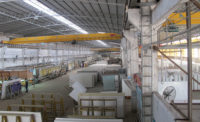Natural stone distributors and fabricators have faced an increase in demand for quartz surfaces over the past decade. Is sourcing quartz the same as sourcing natural stone? No, sourcing quartz material has some differences versus sourcing natural stone. If natural stone looks the same, it probably is the same, and therefore performs the same. This article will explain some of these differences between quartz suppliers so the purchasers in our industry can make the best choices for their customers and their companies.
Are quartz manufacturers different?
There are several factors in the variance between quartz manufacturers, and therefore, the pricing in the marketplace. Raw ingredients and the manufacturing process are two items we will discuss in this article. Some other factors in quartz price variance are import/export duties, freight, exchange rates and politics. These we will not cover.
The raw ingredients in quartz are quartz silica crystals in varying sizes from 3mm quartz crystals down to quartz powder, resin binders, catalysts, UV inhibitors and pigments. The cost of preferred quality resins, catalysts, UV inhibitors and pigments can greatly affect the quality of the final product and therefore performance of the quartz surface over time. Insuring the chemicals used to bind, fill, accelerate the thermo-cure process and protect the lighter colors from yellowing are extremely important for the short- and long-term performance of the surface.
The quartz manufacturing process requires quality built machinery that is installed for producing consistent product. We will not review specific types of machinery in this article, but knowing the raw material mixing/mold filling process, vibro-compressor, oven type, cure time, gauging, polishing line and abrasives used is paramount to selecting your quartz supplier.
The mixing technology of the supplier will affect the design capability and consistency of color. Filling the mold with the mixed ingredients can be automatic, semi-automatic or manual. The mixing method will affect the density and the consistency of the final product, but not to the same degree as the vibro-compression. The vibro-compressor will compact the mold into shape and remove any space between the quartz and the other ingredients. The compressed ingredients will then be put into the oven for thermo-cure. The thermo-cure process requires very particular heat consistency and timing for best cure ensuring the bond is complete and the irreversible chemical reaction has taken place. Improper curing can lead to problems in the performance of the product that may not be visible but can only be determined through laboratory testing. Even the seasonality of production time and manufacturing plant environment can affect the product quality.
We believe that the certifications available today do not accurately detect the ongoing quality concerns of a complete thermo-cure. Extra care must be taken to understand the quality standards of your quartz suppliers’ thermo-cure process to insure the product is safe for you to sell. We will discuss some of the quality standards in the section on “Current Quality Challenges” later in this article.
Once cured, the product is now in raw slab form and will go through gauging of both sides and polishing/finishing of one side. The abrasives and settings of the polishing line will determine the final gauge, gloss level and surface roughness. Surface roughness is also not visibly detectable but can affect the performance of the product. Surface roughness must be tested through a laboratory. Many factories offering quartz products do not use the proper abrasives and polishing techniques to insure the surface is smooth enough to provide long-term stain resistance and clean-ability.
Translucent white quartz/veined quartz (marble designs)
With the increased popularity of marble — and particularly white marble quartz designs — quartz companies have introduced new parameters regarding mixing, resin content and consistency of product. Many of these designs require translucency in background and vein color to achieve accurate marble design imitation. The quartz to resin content of homogenous quartz designs such as pure white should be 93% quartz to 7% resin by weight. The translucent quartz designs will be as high as 85% quartz to 15% resin by weight. These designs require a much higher level of articulation between the raw ingredients, mixing, mold, vibro-compression, thermo-cure and polishing processes than homogenous quartz designs. These complex designs can be subject to ongoing and long-term performance issues if the synergy between these processes is not concise. Expert care should be taken when selecting a source for these designs.
Quality expectations for natural stone design type quartz products need to be viewed as in-between natural stone and homogenous quartz. These quartz designs will be more consistent than natural stone in ongoing color and pattern, but less than homogenous quartz. Consistency within white and light translucent background colors is difficult to achieve past 20 slab lots. Even within these lots there will be some shading differences that the fabricator will need to assess before cutting and joining seams. Care also needs to be taken in joining veins to create a book-match affect or a continuing vein pattern at joints. The slab layout process should be the same as natural stone and expert care needs to be taken to insure the installed product achieves the desired effect.
Marble and other natural stone designs will continue to increase in popularity as the quartz surface allows for a wider range of interior applications due to stain and acid resistance. Careful attention in selecting a source for these designs and understanding translucent quartz design inspection requirements is paramount to ongoing customer satisfaction.
Current quality challenges
In the U.S. today, there are standards that a quartz manufacturer can be required to meet, thus making it known that their product meets a certain quality standard. The ISFA organization developed a standard years ago, but it currently does not have industry perceived authority. So what can a distributor, fabricator or one of their customers use to determine quality?
- One of the most significant quality checks for a quartz product is how well the material has been “polymerized or cured,” and the amount of “Residual Monomer” in the sheet. Residual Monomer (RM) is the unpolymerized monomer that remains in a slab after the reaction has taken place. As you look at spec sheets that manufacturers provide, you rarely see any mention of RM, even though the RM in any given sheet can affect the final surface performance. If you talk with your supplier about your quartz product, don’t be afraid to ask about the RM.
- Another of the lesser known ingredients used in the manufacturing of quartz slabs is an ultraviolet (UV) inhibitor. This ingredient helps prevent the premature fading of the product when exposed to UV light. Well-made quartz will have a quality UV inhibitor added and will hold up under exposure to UV light. Quartz surfaces, especially light colors, without the proper UV inhibitors will fade and discolor over time.
- Dimension of the slabs, and the quality of the workmanship put into the manufacturing of the slab. Slabs should meet the advertised thickness x length x width.
- One should also look for slab flatness and be alert for any warp beyond the advertised tolerance. Sometimes the flatness is affected by the way the slab is stored and may indicate an improperly thermo-cured slab. A quartz supplier should be supplying slabs that are “flat”.
- Fabricators should inspect every slab for color, shade, veining (if applicable), particle continuity, surface imperfections and surface quality. If the inspection reveals a potential issue, the supplier should be contacted before the slab is “cut”. If the slab is not properly inspected before cutting then it will become difficult for the quartz supplier to satisfy an existing claim, as most manufacturers have established a policy where “if you cut it, you own it.” Once the protective plastic sheet is removed from the slab is when it’s the best time to conduct the thorough exam.
- Manufacturers have really improved their color reproducibility from batch to batch. Quartz slabs are essentially made of quartz, colorant and resin. The consistency that the quartz industry has achieved is impressive. Understanding the variation in quartz particles used from translucent to colored with multiple color dispersions and different recipes for creating the final product is a very complex process. Today we now have manufacturers that are creating veined products that mimic a “book-match” pattern. There are also veined slabs that can be cut to continue the vein pattern around corners.
- Gloss levels will be different as manufacturers use different techniques for polishing. The bottom line is that the quality of the surface can have a high gloss, but the surface roughness may be high because the manufacturer did not do an excellent job of polishing through the different steps. At a magnified level, the peaks the eye sees may be polished glossy, but the valleys on the surface are still dull.
Product performance
Through the “Route to Market”, each company that takes title to the product has responsibilities in delivering a quality product. Let’s focus on the responsibilities of the manufacturer and the support they must have in place to support the downstream customers.
First and foremost, the manufacturer must be committed to producing a high-quality product. In the quartz world, this is not as simple as having a good gloss level, good color, particle distribution and or veining. These are the simple product qualities that can be checked by anyone. But the commitment goes much deeper:
- Manufacturer commitment to using high-quality equipment and processes to maximize quality?
- Using quality ingredients?
- Does the manufacturer have a quality program in place with controls set for each step in the process insuring the quality is built into the product, not “inspected” in after the fact?
- Are the slabs identified with color name or number, batch, production date, other identifying marks (left
- or right regarding book-match veining)?
- Does the manufacturer publish a spec data sheet, addressing the key attributes that customers are most interested in? It could be something as simple as gloss, or does the product meet some government requirement for use in food prep or serving areas. Look for a very detailed sheet, and if someone has hardly any data published, it could be an indicator that something may not be the best choice.
- Factory machinery has become varied over the past decade. Let’s face it; usually the machinery is not the problem. It is more likely the people around it who may not practice good maintenance on the equipment or improperly run the process to meet excess demand.
- A good manufacturer will have programs in place to support their network regarding claims and warranty. Manufacturers may also have a program where customers can contact the manufacturer to discuss issues when they feel they are not being heard. The best way to handle a complaint is to direct the customer to the person they bought the material from. If it is not a manufacturer problem, then the appropriate party will have the opportunity to handle it.
- Finally, network amongst your peers or within the industry. There is always someone out there who was the “first person” to use something. Don’t be afraid to reach out and ask for a reference about a product or the application for its use. Manufacturers should gladly offer references outside of your competitive area.
The bottom line is the performance of your quartz product depends on the quality of the product and the minimum standards that your quartz product meets. There can be significant differences between quartz manufacturers and their products. It is best that you understand them so you can make an educated decision on the direction you can take your business to maximize profitability and reduce both short- and long-term quality complaints and callbacks.






